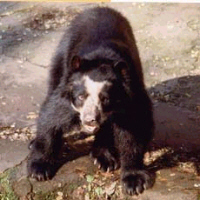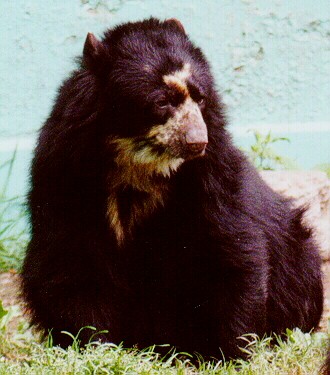
Our Foundation has specific data on the places where spectacled
bear's families find in their natural habitats, these bear's
families have a possession radium or territory of 1 kilometer,
the Foundation have had approaches to these families and the
villagers before our visitors were seeing them with bad eyes,
because they depredated his sown fields, even came up with the
idea of hunting them unknowingly the importance that these bears
that are in danger of extinction have. For the moment they are
in harmony after the proper explanation and conversation with
some villagers, but this not last a great deal and it is due to
this that the Foundation intends to buy these lots and that way
to protect them in his own inhabit and maintaining the zone with
the villagers' help for preserving them, being in project the
first photographic savage tour, which leave to the visitors
taking a photo and seeing in his inhabit these magnificent
mammals naturally. The resources generated by the photographic
tour will be destined to the families directly implicated as
well as the maintenance of this park – reserve . If you wish to
save these families from spectacled bears get in touch with us
right now.
Also we wait for any institution that wishes to accomplish
agreements for studies of this fabulous bear specie.
The spectacled bear, otherwise called Andean bear, of striped
face, ucumari or uyutchine, this bear specie lives in South
America and it looks like more to the giant panda than to the
bears of the north hemisphere. Although in the past his
primitive relatives occupied great part of North America, the
spectacled bear is the only one still alive of the genus
Tremarctos.
 The
spectacled bears are little in comparison with the rest of their
relatives; The female weighs almost 60 kg and the male some 80
kg. The head is not very large and the snout is not very
prominent. The fur is dark, black or chestnut-colored, stained
of white, cream or orange around the chest, the neck and eyes.
The facial stains are very variable of an individual to another
one, but they use to surround the eye forming a ring, complete
or not, as if it wears some spectacles (from there his common
noun comes to it). All fours have five claws, small, sharpened
and powerful; It employs them to climb to the top of the trees
or for to destroy them when it looks for insects. The
spectacled bears are little in comparison with the rest of their
relatives; The female weighs almost 60 kg and the male some 80
kg. The head is not very large and the snout is not very
prominent. The fur is dark, black or chestnut-colored, stained
of white, cream or orange around the chest, the neck and eyes.
The facial stains are very variable of an individual to another
one, but they use to surround the eye forming a ring, complete
or not, as if it wears some spectacles (from there his common
noun comes to it). All fours have five claws, small, sharpened
and powerful; It employs them to climb to the top of the trees
or for to destroy them when it looks for insects.
It feeds on sprout fruits of palm tree, figs, sheets; also it
gets to eat little animals and insects. Pass long times in the
top of the trees and construct nests in the crowns to spend the
night. The spectacled bear is a noisy animal and it emits
different sounds according to its activity or mood. Although it
does not suppose a menace for the human being, in some areas
they fear him and it gets to cause important damages at the
areas of cultivation. His distribution area has diminished very
fast on last years due to the human pressure. Superstition,
hunting or the poaching are another leading causes of the
reduction in these animals populations.
At the same that the other bears, the children of the spectacled bear are
born very small and they are in need of the maternal care to
attain a development and learning complete. The period of
gestation lasts for some seven months and the female gives birth
to one or two children.
that the other bears, the children of the spectacled bear are
born very small and they are in need of the maternal care to
attain a development and learning complete. The period of
gestation lasts for some seven months and the female gives birth
to one or two children.
Scientific classification: The bear of glasses belongs to
the Subfamily Tremarctinae within the family Ursidae in the
order of the Carnivores. Receive the scientific name of
Tremarctos ornatus. |













